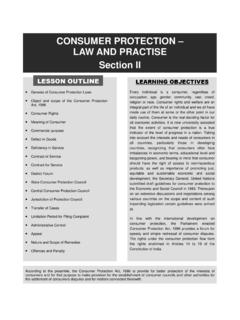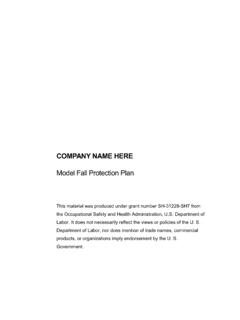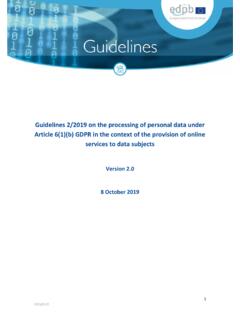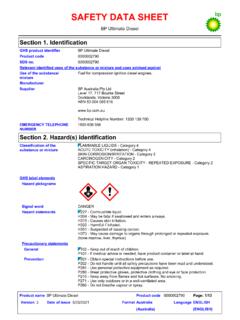Transcription of CONSUMER PROTECTION – LAW AND PRACTISE Section II
1 CONSUMER PROTECTION LAW AND PRACTISE Section II Genesis of CONSUMER PROTECTION Laws Object and scope of the CONSUMER PROTECTION Act, 1986 CONSUMER Rights Meaning of CONSUMER Commercial purpose Defect in Goods Deficiency in Service Contract of Service Contract for Service District Forum State CONSUMER PROTECTION Council Central CONSUMER PROTECTION Council Jurisdiction of PROTECTION Council Transfer of Cases Limitation Period for Filing Complaint Administrative Control Appeal Nature and Scope of Remedies Offences and Penalty Every individual is a CONSUMER , regardless of occupation, age, gender, community.
2 Cast, creed, religion or race. CONSUMER rights and welfare are an integral part of the life of an individual and we all have made use of them at some or the other point in our daily routine. CONSUMER is the real deciding factor for all economic activities. It is now universally accepted that the extent of CONSUMER PROTECTION is a true indicator of the level of progress in a nation. Taking into account the interests and needs of consumers in all countries, particularly those in developing countries, recognizing that consumers often face imbalances in economic terms, educational level and bargaining power, and bearing in mind that CONSUMER should have the right of access to non-hazardous products, as well as importance of promoting just, equitable and sustainable economic and social development, the Secretary General.
3 United Nations submitted draft guidelines for CONSUMER PROTECTION to the Economic and Social Council in 1983. Thereupon on an extensive discussions and negotiations among various countries on the scope and content of such impending legislation certain guidelines were arrived at. In line with the international development on CONSUMER PROTECTION , the Parliament enacted CONSUMER PROTECTION Act, 1986 provides a forum for speedy and simple redressal of CONSUMER disputes. The rights under the CONSUMER PROTECTION flow from the rights enshrined in Articles 14 to 19 of the Constitution of India.
4 According to the preamble, the CONSUMER PROTECTION Act, 1986 to provide for better PROTECTION of the interests of consumers and for that purpose to make provision for the establishment of CONSUMER councils and other authorities for the settlement of consumers disputes and for matters connected therewith. EP-ECL 160 INTRODUCTION A CONSUMER is a user of goods and services, therefore, every producer is also a CONSUMER . However, conflicting interests have categorised them, inevitably, into two different groups.
5 The industrial revolution brought in the concept of standardisation and mass production and over the years, the type of goods and the nature of services available grew manifold. The doctrine of Caveat Emptor or let the buyer beware which came into existence in the middle ages had been replaced by the principle of CONSUMER Sovereignty or CONSUMER is the King . But, with tremendous increase in the world population, the growing markets were unable to meet the rising demand which created a gap between the general demand and supply levels in the markets.
6 This to some extent watered down the concept of CONSUMER Sovereignty , what with consumers being forced to accept whatever was offered to them. On the other hand, the expanding markets necessitated the introduction of various intermediaries between the producer and the ultimate CONSUMER . Advertising , though ostensibly directed at informing potential consumers about the availability and uses of a product began to be resorted to as a medium for exaggerating the uses of ones products or disparaging others products so as to have an edge over competitors.
7 Unfair and deceptive practices such as selling of defective or sub-standard goods, charging exhorbitant prices, misrepresenting the efficacy or usefulness of goods, negligence as to safety standards, etc. became rampant. It, therefore, became necessary to evolve statutory measures, even in developed countries, to make producers/traders more accountable to consumers. It also became inevitable for consumers to unite on a common platform to deal with issues of common concern and having their grievances redressed satisfactorily.
8 Genesis of CONSUMER PROTECTION Laws The need to ensure the basic rights to health, safety, etc. of consumers has long been recognised the worldover and various general legislations were enacted in India and abroad in this direction. In India, the general enactments other than the law of torts which ultimately aimed at PROTECTION of consumers interests are the Indian Contract Act, 1872, the Sale of Goods Act, 1930, the Dangerous Drugs Act, 1930, the Agricultural Produce (Grading and Marketing) Act, 1937, the Drugs and Cosmetics Act, 1940, the Indian Standards Institution (Certification Marks)
9 Act, 1952, the Prevention of Food Adulteration Act, 1954, the Drugs and Magic Remedies (Objectionable Advertisements) Act, 1954, the Essential Commodities Act, 1955, the Standards of Weights and Measures Act, 1976 (Now Legal Metrology Act, 2009), the Trade and Merchandise Marks Act, 1958, (Now Trade Marks Act, 1999), the Patents Act, 1970, the Hire Purchases Act, 1972 and the Prevention of Black Marketing and Maintenance of Supplies of Essential Commodities Act, 1980. These legislations contained regulatory provisions and contravention of these provisions attracted civil liability.
10 This meant that an ordinary CONSUMER had no other remedy but to initiate action by way of a civil suit which involved lengthy legal process proving to be too expensive and time consuming for lay consumers. In fact, at times, the time and cost involved in the legal process was disproportionate to the compensation claimed and granted to an individual CONSUMER . Though the MRTP Commission proved to be far more accessible and less time-consuming than the Civil Courts, its single central location at New Delhi did not make the redressal agency accessible to all consumers, especially those located in the remote towns and villages of the country.












